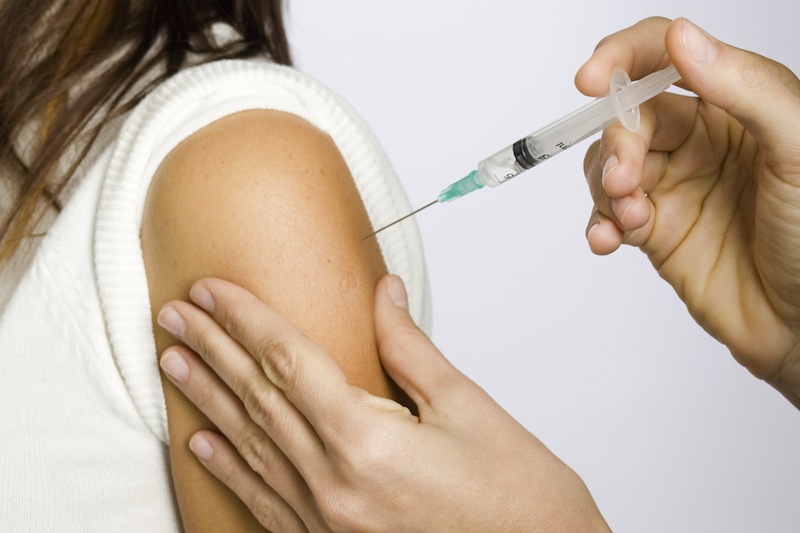More Teen Girls Need HPV Shot, CDC Says

Despite growing evidence that the human papillomavirus vaccine is effective at preventing not only HPV infections but also the cancers they can bring down the line, just one-third of teen girls complete the vaccination series, a new study finds.
In 2012, 53.8 percent of girls ages 13 to 17 received at least one dose of HPV, and 33.4 percent received all three doses needed to complete the series. That's about the same vaccination rate as in 2011, according to the study from the Centers for Disease Control and Prevention (CDC).
Among girls who were not vaccinated, 84 percent visited the doctor and received a vaccine other than HPV after their 11th birthday, meaning these girls missed an opportunity to be vaccinated against HPV, the researchers said. If the HPV vaccine had been administered at these doctor's visits, the percentage of girls who would have received at least one does of HPV would be 92 percent, the researchers said. [See HPV Vaccine: What If You Miss a Dose?]
Each year, HPV causes about 26,200 cancers in the United States, most commonly cervical cancer in women (17,400 cases) and oropharyngeal (throat) cancers in men (8,800 cases), the CDC says. Although the vaccine does not protect against all strains of HPV, it does protect against four strains, including the two strains (HPV16 and HPV18) thought to cause about 70 percent of cervical cancers.
"Today we have disappointing news," Dr. Tom Frieden, director of the CDC, said in a news conference about the study. "We're missing opportunities to give HPV vaccine, and that needs to change to protect girls from cervical cancer," Frieden said.
Frieden noted the lack of increase in improving vaccination rates between 2011 and 2012. "We're used to seeing coverage increases of 10 percent per year when a new vaccine hits the market," Frieden said. "HPV vaccine coverage hasn't kept pace with other vaccines recommended for preteens and teens," he said.
Because the virus is spread through sex, the CDC recommends the vaccine be given before teens become sexually active. Girls and boys should be vaccinated at ages 11 or 12, the CDC says. (Those who were not vaccinated as teenagers are recommended to get the vaccine in their 20s, up to age 26.)
Get the world’s most fascinating discoveries delivered straight to your inbox.
A recent study found that after the HPV vaccine was introduced in 2006, there was a 56 percent decrease in the rate of teen girls infected with any of the four HPV strains included in the vaccine. Studies also suggest that the vaccine can reduce the risk of developing early stages of cervical cancer.
If 80 percent of teen girls were vaccinated against HPV, it is estimated that 53,000 cases of cervical cancer would be prevented over their lifetime, the CDC said.
One way to increase vaccination rates is to educate parents about why the vaccine is recommended, the CDC said. In the new study, about one-quarter of teen parents surveyed said they did not intend to have their child vaccinated within the next year, often because they thought the vaccine wasn’t needed. About 10 percent cited the fact that their child was not sexually active as a reason not to vaccinate, even though the vaccine is recommended for teens before they become sexually active.
Doctors need to step up their efforts to recommend the vaccine and discuss it with parents, so that missed opportunities for vaccination can be reduced, Frieden said.
Studies show the HPV vaccine is safe, and side effects can include pain, redness, and swelling at the injection site as well as fainting. (Doctors recommend that those who are vaccinated be monitored for 15 minutes in case of fainting.)
The new study is published this week, in the CDC's Morbidity and Mortality Weekly Report.
Follow Rachael Rettner @RachaelRettner. Follow LiveScience @livescience, Facebook & Google+. Original article on LiveScience.com.

Rachael is a Live Science contributor, and was a former channel editor and senior writer for Live Science between 2010 and 2022. She has a master's degree in journalism from New York University's Science, Health and Environmental Reporting Program. She also holds a B.S. in molecular biology and an M.S. in biology from the University of California, San Diego. Her work has appeared in Scienceline, The Washington Post and Scientific American.


